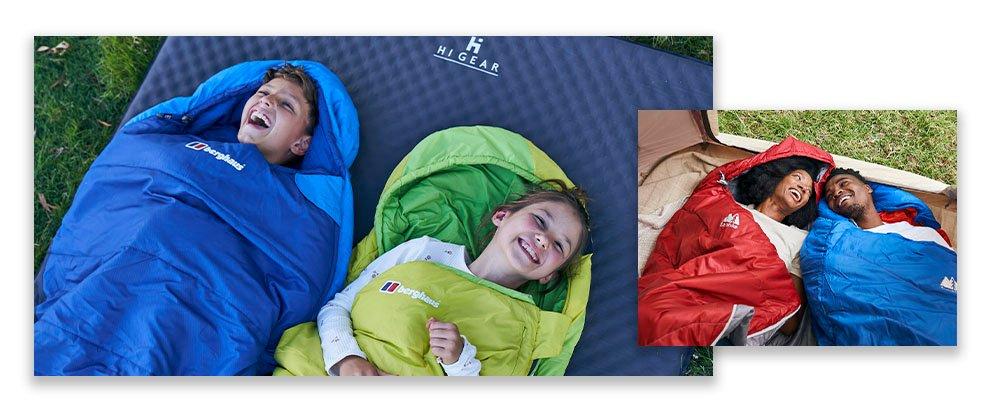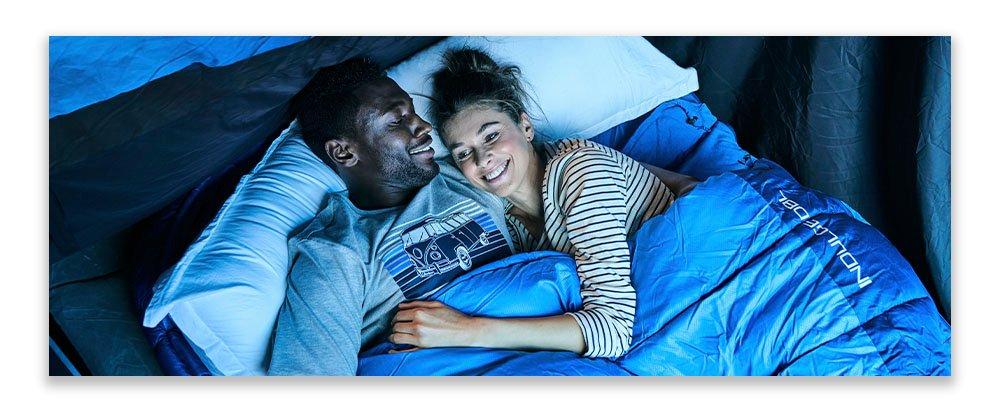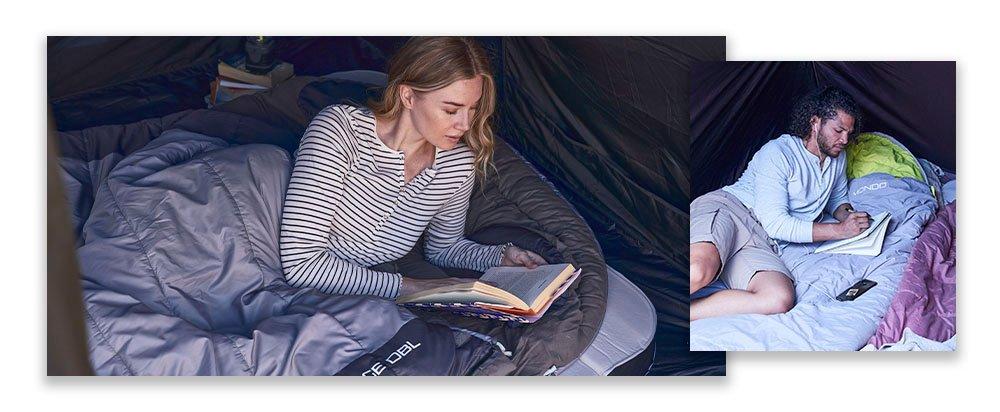0Basket0Item: £0.00
Save £50 on retail prices by being a member
Become a member now or enter your membership number in the basket. More about Membership.
Enjoy your members only prices!
Total items:0
You've picked out your tent, and now you need to think about your sleeping setup. In this guide, we'll take you through what you'll need to consider when buying a sleeping bag.
Everybody has a different temperature when they sleep; some may sleep warmer than others, men and women are known to have differing comfort temperatures and kids are probably even more likely to feel the cold. Plus, different weather conditions mean different sleeping bags are needed. It's important to choose a sleeping bag that works for you and will keep you cosy at night!
Sleeping bags differ in many ways; their size, shape, comfort rating, season rating and different types of insulation. There are 3 different shapes of sleeping bag: Square, Mummy and Sleeping Pod.

These sleeping bags are squared at the top and bottom for that rectangular shape. They give you that home comfort feeling by having zips on both sides so it can be unzipped fully turning it into a duvet, whilst also being able to zip together with an identical bag to create a double sleeping bag. Ideal for when you have a little more room to spare and perfect for caravanning or indoor use. Whilst the rectangular shape may give you familiar home comforts, the sacrifice is that you will not get the same level of warmth compared to a mummy shaped bag. Plus, you’re also adding more bulk and weight because of the design.

The mummy sleeping bag design is best for when you will be carrying a sleeping bag in a rucksack. The close to body tapered shape follows the natural contour of the human body. This shape is best for retaining the most heat as possible, whilst also removing excess bulk and reducing the pack size for easy transport. It is worth noting that if you prefer to stretch and move in your sleep, it may be worth considering a different design.

Sleeping Pods are exclusive to GO Outdoors. They are half as wide as they are long, which means you can move freely inside, making them ideal for people who like to toss and turn in their sleep. Perfect for sleepovers or summer use.
Down sleeping bags are the pinnacle of warmth to weight, delivering impressive warmth in a lightweight, low bulk design. Considered the best for winter expeditions where warmth and weight are the most important factors, they are sure to keep you cosy when temperatures drop. However, down sleeping bags do need a lot of care. When wet, the down feathers lose their loft and insulating properties, so it's best to be careful and treat them with care. Plus, down is more expensive than synthetic. Down sleeping bags will have differing down ratios and a variety of fill powers. The former will tell you the amount of down in the sleeping bag for example 90/10 will contain 90% down plume feathers and 10% non-down feathers. The latter informs you how lofty the down is, 600 fill is considered good, 700 is high quality and 800+ is the best and used for winter expeditions in an alpine environment.
Synthetic sleeping bags use a synthetic form of insulation to help keep the colder air from reaching your body. Synthetic insulation is the most common form of insulation in sleeping bags. It is less expensive than down and will be able to hold around 50% of it’s insulating properties when wet. Synthetic insulation works the same as down by trapping in as much warm air as possible. Synthetic and down share the same temperature ratings however synthetic tends to weigh more and have a larger pack size.
When choosing your sleeping bag, consider what time of year you're heading out camping and whether or not you're more susceptible to the cold. We'd recommend comparing different sleeping bags' season and comfort ratings, which can give you a great indication of when the bag should be used, and what sort of temperatures you will find most comfortable when sleeping. Most sleeping bags are rated by season to help you buy the right sleeping bag for the time of year that you are camping.
When it comes to choosing the right sleeping bag for your outdoor adventures, understanding the different temperature ratings is crucial. Three common ratings you'll often come across are the comfort rating, limit rating, and extreme rating.
• 1 Season - Lightweight, compact and ideal for use in hot summer months (June-August) or when camping abroad in hotter countries
• 2 Season - Ideal for use in late spring to early autumn; your typical family camping sleeping bag
• 3 Season - For use in early spring to late autumn, and perhaps a mild winter evening. These bags are generally the sort of sleeping bag recommended for school trips and expeditions such as DofE
• 4 Season - Thick bags and often down insulated, 4 season sleeping bags are made for use in winter when temperatures can drop below zero
• 4+ Season - These sleeping bags, also known as expedition bags are for high mountain use and for extreme cold temperatures

Comfort Rating
This indicates the lowest temperature at which an average sleeper will feel comfortably warm. If you find that you're more susceptible to the cold, choose a higher comfort rating.
Limit Rating
The limit is the lower limit of temperature that the sleeping bag should be used in. The sleeping bag should not really be used in colder temperatures than the Limit Rating.
Extreme Rating
These ratings are a measure of survival temperature. It’s the temperature that a person would "survive" the night in the sleeping bag, but not sleep or be in any comfort at all. The sleeping bag should only be used in this temperature as a last resort or emergency.*
*But don’t forget, these temperatures are purely a guide. Everybody sleeps differently, and the difference between men's and women's body temperatures at night can be quite significant. Do not fall under the impression that you’ll be fine because the extreme temperature says you will. If you use a sleeping bag in the extreme temperature range, it’s going to be a dangerous night’s sleep.
You may notice that some sleeping bags will mention whether they have a left hand or right-hand zip. While this may seem a trivial feature, it's actually quite awkward to zip up a sleeping bag if the zip is on the wrong side.
Simply remember- Left Hand Zip for Right-Handed People, Right Hand Zip for Left-Handed People.
It's also worth knowing depending on which side you normally sleep on it’s better to the keep the zip at your back rather than your front for added comfort.
It's also worth knowing depending on which side you normally sleep on it’s better to the keep the zip at your back rather than your front for added comfort.
The pack size is how small the sleeping bag is when packed away. This is generally not an important factor for family campers. However, if you are backpacking or travelling light and need your sleeping bag to attach to your rucksack for long periods of time, it's worth noting the pack size and the weight. For thicker sleeping bags, a compression sack can reduce the volume of your packed bag. Down sleeping bags are known for their excellent compressibility, so if a lightweight pack size is an imperative, then a down sleeping bag is best.
